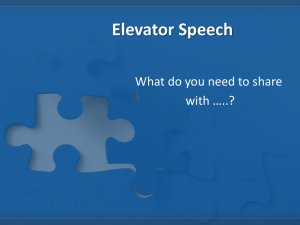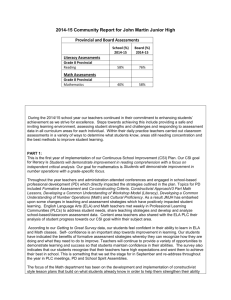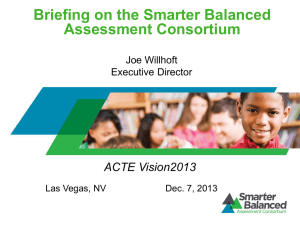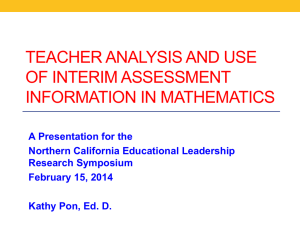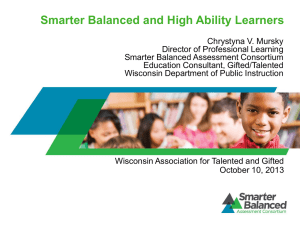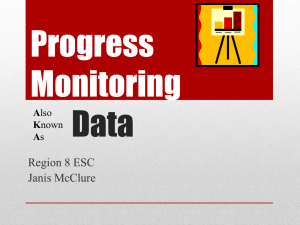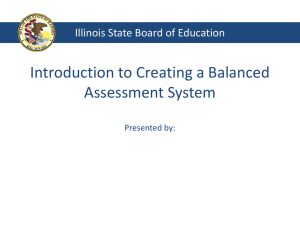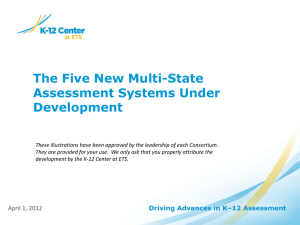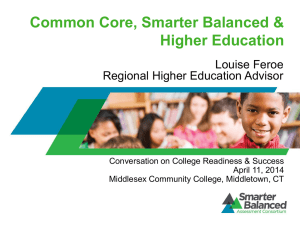Smarter Balanced Presentation - Educational Service District 113
advertisement
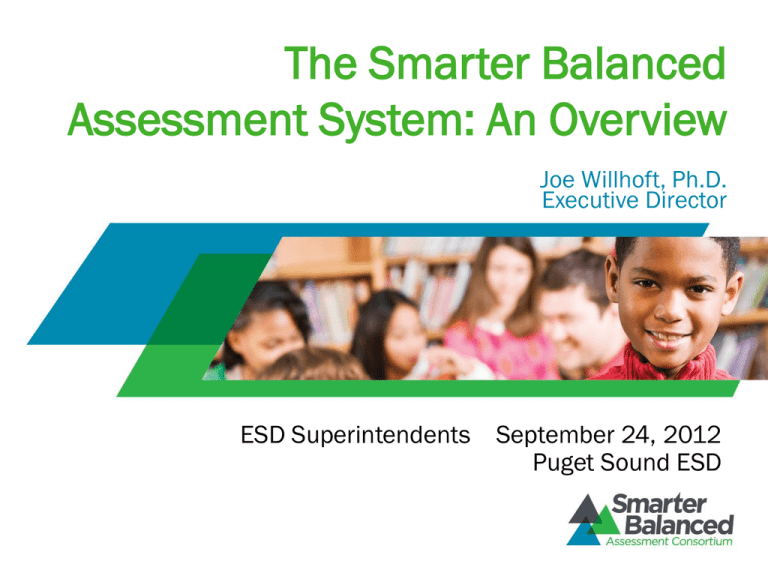
The Smarter Balanced Assessment System: An Overview Joe Willhoft, Ph.D. Executive Director ESD Superintendents September 24, 2012 Puget Sound ESD Common Core State Standards • • • Define the knowledge and skills students need for college and career Developed voluntarily and cooperatively by states; more than 40 states have adopted Provide clear, consistent standards in English language arts/Literacy and mathematics Source: www.corestandards.org A Next Generation of Assessments US Dept. of Ed has funded two consortia of states with development grants for new assessments aligned to Common Core State Standards • • • • • • • Rigorous assessment of progress toward “college and career readiness” Common cut scores across all Consortium states Provide both achievement and growth information Valid, reliable, and fair for all students, except those with “significant cognitive disabilities” Administered online Use multiple measures Operational in 2014-15 school year (Federal Register / Vol. 75, No. 68 / Friday, April 9, 2010 pp. 18171-85) Smarter Balanced: A State-led Consortium A National Consortium of States • • • • 25 states representing 40% of K-12 students 21 governing, 4 advisory states Washington state is fiscal agent WestEd provides project management services The Smarter Balanced Assessment System A Balanced Assessment System Common Core State Standards specify K-12 expectations for college and career readiness Summative: College and career readiness assessments for accountability Teachers and schools have information and tools they need to improve teaching and learning Formative resources: Supporting classroom-based assessments to improve instruction Interim: Flexible and open assessments, used for actionable feedback All students leave high school college and career ready Summative Assessments for Accountability Computer Adaptive Testing (CAT) Portion Performance Task (PT) Portion Setting Performance Standards (Cut Scores) ✔ •Built on solid technology •Coverage of full breadth/depth of Common Core •Precise assessment of all students •Deeper learning with thematic and scenario-based tasks •Real-world problems aligned to Common Core •PT scores combined with CAT for overall score •K-12, higher ed, business, and policymakers part of decision-making •Broad review of “Achievement Level Descriptors” •Field testing includes PISA, TIMSS, NAEP items •Longitudinal data systems used for triangulation Page 8 Interim Assessments to Signal Improvement ✔ Flexible •Non-Secure •Timing and frequency are locally determined •Interim test-builder creates aligned assessments Supports Proficiency Based Instruction •Teachers can match assessments with scope and sequence •Teachers can review student responses •Teachers can score student responses Authentic Measures •Includes full range of item types •Uses the same scale as the Summative Assessment •Includes performance assessments Page 9 Summative and Interim Use of Computer Adaptive Technology Faster results, fewer items ✔ ✔ •Turnaround time is significantly reduced •Can assess broad range with fewer items Deeper Analysis •Reports for classrooms and schools draw from the full range of items seen by many students Increased precision •Accurate measurement across range of students •Improved measures of student growth over time Tailored to student ability •Item difficulty based on student responses Greater security •Large item pool means not all students receive the same questions Mature technology •GMAT, GRE, COMPASS (ACT), Measures of Academic Progress (MAP) Page 10 Formative Tools for ClassroomBased Assessment Practices Improving Instruction Pooling Resources ✔ •Tools/materials for Classroom-based Assessments •Fully aligned to Common Core State Standards •Available for in-service and pre-service development •Access to the best resources available •Collaborate with other states on special projects •Professional social networking across the Consortium •Tools to evaluate publishers’ tests Page 11 A Balanced Assessment System English Language Arts/Literacy and Mathematics, Grades 3-8 and High School School Year Last 12 weeks of the year* DIGITAL CLEARINGHOUSE OF FORMATIVE TOOLS, PROCESSES AND EXEMPLARS Released items and tasks; Model curriculum units; Educator training; Professional development tools and resources; Scorer training modules; Teacher collaboration tools; Evaluation of publishers’ assessments. Optional Interim Assessment Computer Adaptive Assessment and Performance Tasks Optional Interim Assessment Computer Adaptive Assessment and Performance Tasks PERFORMANCE TASKS • ELA/Literacy • Mathematics Scope, sequence, number and timing of interim assessments locally determined *Time windows may be adjusted based on results from the research agenda and final implementation decisions. COMPUTER ADAPTIVE TESTS • ELA/Literacy • Mathematics Re-take option Engaging Educators K-12 Educator Involvement •Support for implementation of the Common Core State Standards (2011-12) •Write and review items/tasks for the for the pilot test (2012-13) and field test (2013-14) •Development of educator leadership teams in each state (2012-14) •Evaluate formative assessment practices and curriculum tools for inclusion in digital library (2013-14) •Score portions of the interim and summative assessments (2014-15 and beyond) Higher Education Collaboration •Involved 175 public and 13 private systems/institutions of higher education in application •Two higher education reps on the Executive Committee •Higher education lead in each state and higher education faculty participating in work groups •Goal: The high school assessment qualifies students for entry-level, credit-bearing coursework in college or university Progress and Timeline Assessment Claims for ELA / Literacy Overall Claim (Gr. 3-8) Overall Claim (High School) “Students can demonstrate progress toward college and career readiness in English Language arts and literacy.” “Students can demonstrate college and career readiness in English language arts and literacy.” Reading “Students can read closely and analytically to comprehend a range of increasingly complex literary and informational texts.” Writing “Students can produce effective and well-grounded writing for a range of purposes and audiences.” Speaking and Listening “Students can employ effective speaking and listening skills for a range of purposes and audiences.” Research/Inquiry “Students can engage in research and inquiry to investigate topics, and to analyze, integrate, and present information.” Assessment Claims for Mathematics Overall Claim (Gr. 3-8) Overall Claim (High School) “Students can demonstrate progress toward college and career readiness in mathematics.” “Students can demonstrate college and career readiness in mathematics.” Concepts and Procedures “Students can explain and apply mathematical concepts and interpret and carry out mathematical procedures with precision and fluency.” Problem Solving “Students can solve a range of complex well-posed problems in pure and applied mathematics, making productive use of knowledge and problem solving strategies.” Communicating Reasoning “Students can clearly and precisely construct viable arguments to support their own reasoning and to critique the reasoning of others.” Modeling and Data Analysis “Students can analyze complex, real-world scenarios and can construct and use mathematical models to interpret and solve problems.” Technology Guidelines for New Purchases (v1.0 Apr. 2012) Available Display Minimum Processor RAM Memory/Storage Resolution Size for New Speed Hardware 1.0 GHz 1 GB 1 GB 1024x768 10” Class Windows 7 Operating Mac 10.7 Systems Linux (Ubuntu 11.10; Fedora 16) Chrome Apple iOS Android 4.0 Desktops, laptops, netbooks (Windows, Mac, Chrome, Linux), thin client, and tablets (iPad, Windows, and Android) will be compatible devices provided they are configured to meet the established hardware, operating system, and networking specifications -- and are able to be “locked down”. 19 Major Milestones All-Call for Pilot Testing State Educator Teams Begin Item/Task Writing Begins Interim & Formative Available for Use All-Call for Field Testing IT Readiness Reports Set Performance Standards (Cut Scores) IT Readiness Reports Operational Summative Assessment IT Readiness Reports Verify Performance Standards Small Scale Trials Pilot of 10,000 Items/Tasks Field Test 37,000 Items/Tasks Page 20 Released Items & Tasks Item Development Process • • • • • • Early 2012: Assessment claims for ELA/literacy and mathematics approved April 2012: Item/task specifications and review guidelines complete June 2012: Training modules available for item writers/reviewers Summer 2012: Educators from Governing States begin writing items and tasks; cognitive labs / small scale trials begin Early October: Sample items available February / May 2013: Pilot Test of initial 10,000 items and performance tasks Purpose of the Sample Items & Tasks • • • Illustrate rigor and complexity of ELA/literacy and mathematics items on Smarter Balanced assessments Signal to educators the shifts in instruction that will be required to help students meet the demands of the Common Core and new assessments Showcase variety of item types: • • • • Selected response Constructed response Technology enhanced Performance tasks Exploring the Sample Items/Tasks • • • • • Accessed online through a simulated test platform Viewable by: – – – – Grade band (3-5, 6-8, and high school) Content claim Select types (technology enhanced and performance tasks) Themes to illustrate learning across grades and difficulty progressions – – – – – Grade level Smarter Balanced content claim & assessment target Alignment to Common Core State Standards Brief descriptions Selected scoring rubrics Metadata for each item/task includes: Selected response and technology enhanced items are machine scorable Online feedback and phone support available Accessibility and Accommodations • • Sample items/tasks do not include accessibility and accommodations features Full range of accessibility tools and accommodations options under development guided by: – Magda Chia, Ph.D., Director of Support for UnderRepresented Students – Accessibility and Accommodations Work Group – Students with Disabilities Advisory Committee • Chair: Martha Thurlow (NCEO) – English Language Learners Advisory Committee • Co-Chairs: Jamal Abedi (UC Davis) & Kenji Hakuta (Stanford) Visit us at: SmarterBalanced.org
